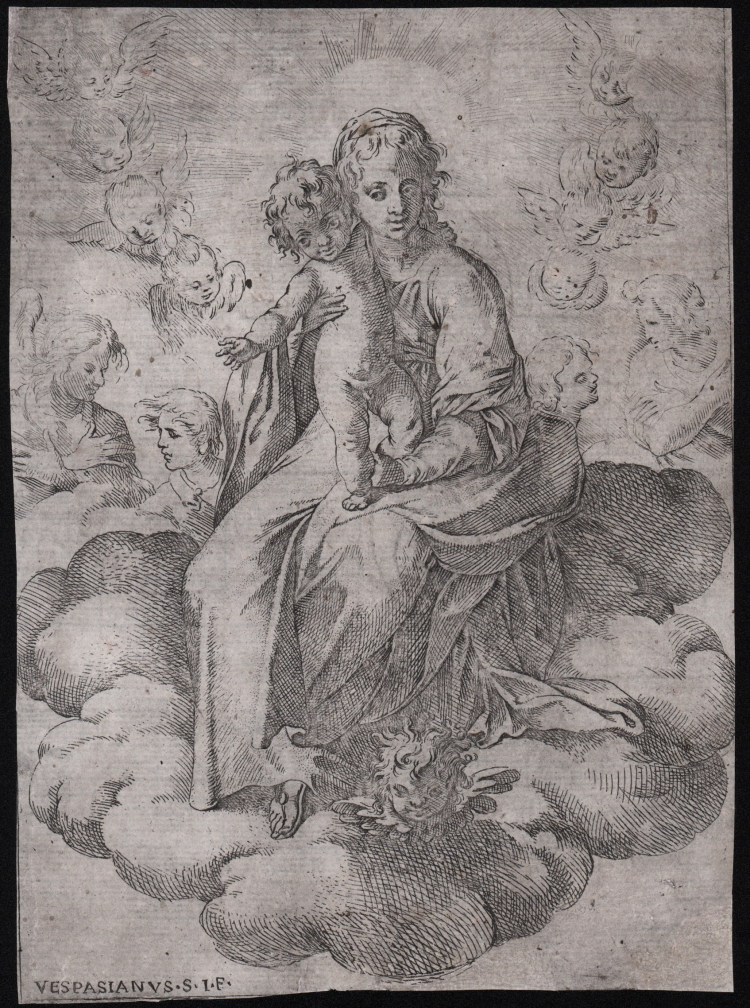




| Reference: | S47177 |
| Author | Vespasiano STRADA |
| Year: | 1610 ca. |
| Measures: | 135 x 190 mm |



| Reference: | S47177 |
| Author | Vespasiano STRADA |
| Year: | 1610 ca. |
| Measures: | 135 x 190 mm |
The Virgin and Child seated on clouds with the head of an angel below.
Etching, inscribed at the bottom left "Vespasianus S I F".
Good impressiion, printed on contemporary laid paper, perfectly executed restorations at the corners, otherwise in good condition.
Vespasiano Strada (Rome 1582 ca. – 1622) was a painter and engraver, son of a Spanish painter who settled in Rome. He enrolled in the Accademia di San Luca in 1604 and in the Accademia dei Virtuosi in 1622. He created works mainly for ecclesiastical commissions, but his specialty, according to Baglione, was “dipinger sopra de' corami, e sì bene li coloriva che tutti i coramari di Roma da lui si servivano e buon guadagno ne ritraeva” [painting on leather, and he colored them so well that all the leather workers in Rome used him and he made good money from them]. This note shows the working style of a typical craftsman-artist of 17th century Rome, of good workmanship. Bartsch attributes to him 21 engravings with scenes from the New Testament or the life of the Saints as their subject. Even in the use of the engraving technique, an inclination towards pictorial effects is evident, which in some ways brings him closer to Ventura Salimbeni (Siena 1568 - 1613).
Bibliografia
Bartsch, Le Peintre graveur ((XVII.307.12)
Vespasiano STRADA (Roma 1582 – 1622)
|
Italian painter and etcher of Spanish origin. He is thought to have trained with Ventura Salimbeni, who deeply influenced his art. Baglione listed frescoes in the oratory of S Giacomo di Scossacavalli, in S Maria d’Aracoeli (showing the Miracles of S Diego) and in the cloister of S Onofrio, all Roman churches, as being among his most important works as a painter. Twenty-one etchings have been attributed to him by Bartsch; they feature religious subjects and include variants on the theme of the Virgin and Child. They are uneven in quality and hence presumed to have been executed in different phases of the artist’s career.
|
Vespasiano STRADA (Roma 1582 – 1622)
|
Italian painter and etcher of Spanish origin. He is thought to have trained with Ventura Salimbeni, who deeply influenced his art. Baglione listed frescoes in the oratory of S Giacomo di Scossacavalli, in S Maria d’Aracoeli (showing the Miracles of S Diego) and in the cloister of S Onofrio, all Roman churches, as being among his most important works as a painter. Twenty-one etchings have been attributed to him by Bartsch; they feature religious subjects and include variants on the theme of the Virgin and Child. They are uneven in quality and hence presumed to have been executed in different phases of the artist’s career.
|